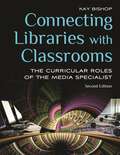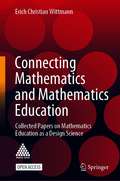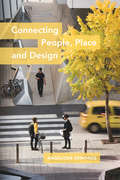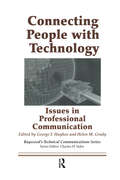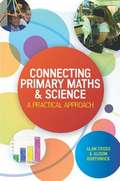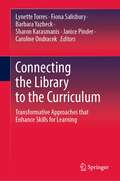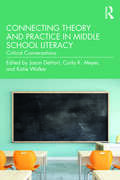- Table View
- List View
Connecting Leadership and Learning: Principles for Practice
by John MacBeath Neil DempsterLeading schools is becoming almost daily a more complex and demanding job. Connecting Leadership and Learning reassesses the purpose of schools, the nature of learning and the qualities of leadership that make schools authentic places of learning. Starting with a review of what we can claim to know – and not know – about learning, leadership and their inter-relationship, this book explores what it means to lead schools that place learning at the centre. Drawing on research from seven different country projects - including the United States, Australia and five European countries – the authors offer five key principles for practice: a focus of learning an environment for learning a learning dialogue shared leadership accountability; internal and external. These key principles have been tested by teachers, senior leaders and school students and found to be applicable across cultural and linguistic boundaries. The challenges faced by in inner city schools, whether in London or New Jersey, prove a stern test for the five principles yet, as these schools testify, they bring a new sense of hope and resolve that learning is for everyone. Based on rigorous research yet thoroughly grounded in practice, this book aims to challenge the reader with big ideas about learning and leadership, and to break new ground in thinking about where leadership and learning meet so that practitioners can see how it works in school and classroom practice. It should be of interest to all school leaders and those aspiring to the role.
Connecting Libraries with Classrooms: The Curricular Roles of the Media Specialist
by Kay BishopThis book provides an in-depth exploration of the topics that are currently relevant in K–12 curricula, including the school librarian's role in dealing with these issues, collaborating with teachers, and connecting to classrooms.This latest version of Connecting Libraries with Classrooms: The Curricular Roles of the Media Specialist is intended to help school librarians to collaborate with teachers in subject areas, meet the needs of special groups of students, and be fully aware of important educational trends.The first chapter covers collaboration and partnerships within the school setting, providing a background for the subsequent subject matter. The balance of the book addresses the role of the school librarian in the modern K–12 curriculum. This information is organized into the curricula of reading, music, and English as a second language; three groups of special students (students with autism, highly mobile students, and LGBT students); and critical trends in education—Web 2.0, distance education, and inclusion. This resource is an invaluable aid for practicing school librarians and serve as a core textbook for preservice school librarians.
Connecting Mathematics and Mathematics Education: Collected Papers on Mathematics Education as a Design Science
by Erich Christian WittmannThis open access book features a selection of articles written by Erich Ch. Wittmann between 1984 to 2019, which shows how the “design science conception” has been continuously developed over a number of decades. The articles not only describe this conception in general terms, but also demonstrate various substantial learning environments that serve as typical examples. In terms of teacher education, the book provides clear information on how to combine (well-understood) mathematics and methods courses to benefit of teachers. The role of mathematics in mathematics education is often explicitly and implicitly reduced to the delivery of subject matter that then has to be selected and made palpable for students using methods imported from psychology, sociology, educational research and related disciplines. While these fields have made significant contributions to mathematics education in recent decades, it cannot be ignored that mathematics itself, if well understood, provides essential knowledge for teaching mathematics beyond the pure delivery of subject matter. For this purpose, mathematics has to be conceived of as an organism that is deeply rooted in elementary operations of the human mind, which can be seamlessly developed to higher and higher levels so that the full richness of problems of various degrees of difficulty, and different means of representation, problem-solving strategies, and forms of proof can be used in ways that are appropriate for the respective level. This view of mathematics is essential for designing learning environments and curricula, for conducting empirical studies on truly mathematical processes and also for implementing the findings of mathematics education in teacher education, where it is crucial to take systemic constraints into account.
Connecting Non Full-time Faculty to Institutional Mission: A Guidebook for College/University Administrators and Faculty Developers
by Leora Baron-NixonNon full-time faculty—whether adjunct, part-time or contingent—has become the lifeline of a vast majority of colleges and universities. They teach many of the foundation and core courses taken by first- and second-year students, teach professional courses in which their own life experiences are invaluable, and step in at short notice to fill-in for regular faculty engaged in research or away on sabbaticals.A survey of over 4,000 institutions conducted by the US Department of Education reveals that such faculty are being hired at a much higher rate than their full-time counterparts--whether in response to increased enrollments, reduced budgets, or changing administrative strategies.The increasing presence of such faculty on campus can conflict with today’s demands for accountability and the pursuit of institutional mission. This book provides academic administrators and faculty developers with proactive, practical and results-producing approaches that can help transform fragmented faculties into integrated and cohesive teaching and scholarly communities.In an easy-to-follow format, this book constitutes a resource of thoughtful and pragmatic strategies to ensure quality and satisfaction both on the part of the institution and the adjuncts. Topics are presented in a thematic sequence that allows decision-makers to focus on their priority areas. The author offers guidance for systematic planning and implementation.The contents are focused on connecting non full-time faculty to core institutional functions and structures: Connection #1--to the institution; Connection #2--to the department; Connection #3--to teaching; Connection #4--to Students; and Connection #5--to scholarship.Originally announced as "Connecting Adjunct Faculty to the Academic Institution"
Connecting Non Full-time Faculty to Institutional Mission: A Guidebook for College/University Administrators and Faculty Developers
by Leora Baron-NixonNon full-time faculty—whether adjunct, part-time or contingent—has become the lifeline of a vast majority of colleges and universities. They teach many of the foundation and core courses taken by first- and second-year students, teach professional courses in which their own life experiences are invaluable, and step in at short notice to fill-in for regular faculty engaged in research or away on sabbaticals.A survey of over 4,000 institutions conducted by the US Department of Education reveals that such faculty are being hired at a much higher rate than their full-time counterparts--whether in response to increased enrollments, reduced budgets, or changing administrative strategies.The increasing presence of such faculty on campus can conflict with today’s demands for accountability and the pursuit of institutional mission. This book provides academic administrators and faculty developers with proactive, practical and results-producing approaches that can help transform fragmented faculties into integrated and cohesive teaching and scholarly communities.In an easy-to-follow format, this book constitutes a resource of thoughtful and pragmatic strategies to ensure quality and satisfaction both on the part of the institution and the adjuncts. Topics are presented in a thematic sequence that allows decision-makers to focus on their priority areas. The author offers guidance for systematic planning and implementation.The contents are focused on connecting non full-time faculty to core institutional functions and structures: Connection #1--to the institution; Connection #2--to the department; Connection #3--to teaching; Connection #4--to Students; and Connection #5--to scholarship.Originally announced as "Connecting Adjunct Faculty to the Academic Institution"
Connecting Past and Present: Concepts and Models for Service-Learning in History
by Ira Harkavy Bill M. DonovanThe question that animates volume, 16th in the Service-Learning in the Disciplines Series, is: Why connect service-learning to history courses? The contributors answer that question in different ways and illustrate and highlight a diversity of historical approaches and interpretations. All agree, however, that they do their jobs better as teachers (and in some cases as researchers) by engaging their students in service-learning. An interesting read with a compelling case for the importance of history and how service-learning can improve the historian’s craft.
Connecting Past and Present: Concepts and Models for Service-Learning in History
The question that animates volume, 16th in the Service-Learning in the Disciplines Series, is: Why connect service-learning to history courses? The contributors answer that question in different ways and illustrate and highlight a diversity of historical approaches and interpretations. All agree, however, that they do their jobs better as teachers (and in some cases as researchers) by engaging their students in service-learning. An interesting read with a compelling case for the importance of history and how service-learning can improve the historian’s craft.
Connecting People, Place and Design
by Angelique EdmondsConnecting People, Place and Design examines the human relationship with place, how its significance has evolved over time and how contemporary systems for participation shape the places around us. This volume examines people, place and design across architecture, design, cultural studies, sociology, political science and philosophy.
Connecting People with Technology: Issues in Professional Communication (Baywood's Technical Communications)
by George F. HayhoeThis book explores five important areas where technology affects society, and suggests ways in which human communication can facilitate the use of that technology.Usability has become a foundational discipline in technical and professional communication that grows out of our rhetorical roots, which emphasize purpose and audience. As our appreciation of audience has grown beyond engineers and scientists to lay users of technology, our appreciation of the diversity of those audiences in terms of age, geography, and other factors has similarly expanded.We are also coming to grips with what Thomas Friedman calls the 'flat world,' a paradigm that influences how we communicate with members of other cultures and speakers of other languages. And because most of the flatteners are either technologies themselves or technology-driven, technical and professional communicators need to leverage these technologies to serve global audiences.Similarly, we are inundated with information about world crises involving health and safety issues. These crises are driven by the effects of terrorism, the aging population, HIV/AIDS, and both human-made and natural disasters. These issues are becoming more visible because they are literally matters of life and death. Furthermore, they are of special concern to audiences that technical and professional communicators have little experience targeting - the shapers of public policy, seniors, adolescents, and those affected by disaster.Biotechnology is another area that has provided new roles for technical and professional communicators. We are only beginning to understand how to communicate the science accurately without either deceiving or panicking our audience. We need to develop a more sophisticated understanding of how communication can shape reactions to biotechnology developments. Confronting this complex network of issues, we're challenged to fashion both our message and the audience's perceptions ethically.Finally, today's corporate environment is being shaped by technology and the global nature of business. Technical and professional communicators can play a role in capturing and managing knowledge, in using technology effectively in the virtual workplace, and in understanding how language shapes organizational culture.
Connecting People with Technology: Issues in Professional Communication (Baywood's Technical Communications)
by George Hayhoe Helen M. M. GradyThis book explores five important areas where technology affects society, and suggests ways in which human communication can facilitate the use of that technology.Usability has become a foundational discipline in technical and professional communication that grows out of our rhetorical roots, which emphasize purpose and audience. As our appreciation of audience has grown beyond engineers and scientists to lay users of technology, our appreciation of the diversity of those audiences in terms of age, geography, and other factors has similarly expanded.We are also coming to grips with what Thomas Friedman calls the 'flat world,' a paradigm that influences how we communicate with members of other cultures and speakers of other languages. And because most of the flatteners are either technologies themselves or technology-driven, technical and professional communicators need to leverage these technologies to serve global audiences.Similarly, we are inundated with information about world crises involving health and safety issues. These crises are driven by the effects of terrorism, the aging population, HIV/AIDS, and both human-made and natural disasters. These issues are becoming more visible because they are literally matters of life and death. Furthermore, they are of special concern to audiences that technical and professional communicators have little experience targeting - the shapers of public policy, seniors, adolescents, and those affected by disaster.Biotechnology is another area that has provided new roles for technical and professional communicators. We are only beginning to understand how to communicate the science accurately without either deceiving or panicking our audience. We need to develop a more sophisticated understanding of how communication can shape reactions to biotechnology developments. Confronting this complex network of issues, we're challenged to fashion both our message and the audience's perceptions ethically.Finally, today's corporate environment is being shaped by technology and the global nature of business. Technical and professional communicators can play a role in capturing and managing knowledge, in using technology effectively in the virtual workplace, and in understanding how language shapes organizational culture.
Connecting Primary Maths and Science: A Practical Approach
by Alan Cross Alison BorthwickAt last, a unique book that explores and exploits the links between primary mathematics and science so that you can promote learning in both of these important STEM subjects! Rich in engaging ideas and activities for the classroom this book helps you plan and teach well-structured lessons in a more integrated way.The book outlines key curriculum topics in both subjects and considers why it is important and beneficial to make connections between the two. As well as covering key subject knowledge (what you need to know) and teaching activities (what you need to do), the book explores learners’ mathematical and scientific needs, and defines the characteristics of effective teaching and learning, bringing it all together with ideas which you can use straightway in your classroom. Key features:• promotes an informed approach to integrating primary mathematics and science teaching• helps address the time constraints of delivering the primary national curriculum• presents engaging ideas which can be directly transferred to the classroom• provides a real-life context to mathematics and science activities to inspire student learning• helps you combine two closely related and sometimes tricky subject areas – why teach one subject when you can teach two at the same time!"Accessible, readable and engaging with a range of innovative teaching ideas, this is an invaluable book for all trainee and qualified primary teachers and other educational professionals with links to primary mathematics and science.A great 'go to' book for teachers and trainee teachers alike.Chapters are constructed with easy to read objectives and clear summaries. Many practical ideas, incorporating current research, as well as information on mathematicians and scientists, which is great for boosting children’s aspirations and also helping with teachers’ confidence on the subjects.A lovely, easy to access book, whether it is to use for reference, to dip in and out of or just to use alongside planning materials."Maria McArdle, Senior Lecturer PGCE & Mathematics Lead (Primary), University of Bedfordshire, UK
Connecting Reading & Writing in Second Language Writing Instruction, Second Edition (The Michigan Series on Teaching Multilingual Writers)
by Alan R. HirvelaIn this substantively revised new edition, Hirvela moves beyond the argument he made in the first edition of the value of connecting reading and writing. This new edition explains various dimensions of those connections and offers a fresh look at how to implement them in L2 writing instruction. It also provides both new and experienced teachers of writing with a solid grounding in the theoretical foundations and pedagogical possibilities associated with reading-writing connections. The new edition features two new chapters. The first is a chapter on assessment because students are now being asked to connect reading and writing in the classroom and on formal assessments like the TOEFL®. The second new chapter is an argument for accounting for transfer elements in the teaching and researching of reading-writing connections. The goals of this revised volume are to provide: resources for those wishing to pursue reading-writing connections, summaries of the beliefs underlying those connections, ideas for teaching the connections in the classroom, and information about the work others have done to develop this domain of L2 writing.
Connecting Research and Practice for Educational Improvement: Ethical and Equitable Approaches
by Bronwyn Bevan William R. PenuelConnecting Research and Practice for Educational Improvement presents powerful arguments and richly illustrated cases for how more collaborative relationships between researchers and educators can yield more relevant research that impacts practice. This book can be useful for anyone teaching or learning about research–practice partnerships, in both school and out-of-school settings. The chapters highlight the different dispositions and skills needed to cultivate ethical relationships and promote equity through partnerships and provide rich frameworks for guiding future work.
Connecting Research and Practice for Educational Improvement: Ethical and Equitable Approaches
by Bronwyn Bevan William R. PenuelConnecting Research and Practice for Educational Improvement presents powerful arguments and richly illustrated cases for how more collaborative relationships between researchers and educators can yield more relevant research that impacts practice. This book can be useful for anyone teaching or learning about research–practice partnerships, in both school and out-of-school settings. The chapters highlight the different dispositions and skills needed to cultivate ethical relationships and promote equity through partnerships and provide rich frameworks for guiding future work.
Connecting Science and Engineering Education Practices in Meaningful Ways: Building Bridges (Contemporary Trends and Issues in Science Education #44)
by Leonard A. Annetta James MinogueThe need for a scientifically literate citizenry, one that is able to think critically and engage productively in the engineering design process, has never been greater. By raising engineering design to the same level as scientific inquiry the Next Generation Science Standards’ (NGSS) have signaled their commitment to the integration of engineering design into the fabric of science education. This call has raised many critical questions...How well do these new standards represent what actually engineers do? Where do the deep connections among science and engineering practices lie? To what extent can (or even should) science and engineering practices co-exist in formal and informal educational spaces? Which of the core science concepts are best to leverage in the pursuit of coherent and compelling integration of engineering practices? What science important content may be pushed aside? This book, tackles many of these tough questions head on.All of the contributing authors consider the same core question: Given the rapidly changing landscape of science education, including the elevated status of engineering design, what are the best approaches to the effective integration of the science and engineering practices? They answered with rich descriptions of pioneering approaches, critical insights, and useful practical examples of how embodying a culture of interdisciplinarity and innovation can fuel the development of a scientifically literate citizenry. This collection of work builds traversable bridges across diverse research communities and begins to break down long standing disciplinary silos that have historically often hamstrung well-meaning efforts to bring research and practice from science and engineering together in meaningful and lasting ways.
Connecting Self-regulated Learning and Performance with Instruction Across High School Content Areas
by Maria K. DiBenedettoThis book shows how principles of self-regulated learning are being implemented in secondary classrooms. The 14 chapters are theoretically driven and supported by empirical research and address all common high school content areas. The book comprises 29 lesson plans in English language arts, natural and physical sciences, social studies, mathematics, foreign language, art, music, health, and physical education. Additionally, the chapters address students with special needs, technology, and homework.Each chapter begins with one or more lesson plans written by master teachers, followed by narratives explaining how the lesson plans were implemented. The chapters conclude with an analysis written by expert researchers of the self-regulated learning elements in the lessons. Each lesson and each analysis incorporate relevant educational standards for that area. Different types of high schools in several states serve as venues.This powerful new book edited by Maria K. DiBenedetto provides a unique and invaluable resource for both secondary teachers and researchers committed to supporting adolescents in the development of academic self-regulation. Each chapter is jointly written by teachers who provide a wealth of materials, including lesson plans, and researchers who situate these lesson plans and academic self-regulation goals within the larger work on self-regulation. The topics covered are far broader than any other book I have seen in terms of developing academic self-regulation, covering over a dozen content areas, including literacy, mathematics, social studies, the sciences, and the arts. Teachers and scholars alike will find this book a must read.Karen Harris, EdD, Arizona State UniversityA practical and magnificent blend of educational research and application. This book goes beyond presenting the findings of research on self regulation by connecting detailed strategies that align with the standards to the research. DiBenedetto et al. clearly illustrate how to develop self regulated learners in the classroom. A refreshing must read for all secondary educators and educational researchers seeking to be well grounded in education research and practical application techniques. Heather Brookman, PhD, Fusion Academy- Park Avenue Self-regulated learning is a research-based process by which teachers help students realize their own role in the learning process. Connecting Self-Regulated Learning and Performance with Instruction Across High School Content Areas consists of model teachers’ lessons and analyses by prominent educational psychologists in the field of self-regulated learning. The book provides teachers with the tools needed to increase students’ awareness of learning and inspires all educators to use self-regulated learning to promote engagement, motivation, and achievement in their students. The book also provides administrators with the principles needed to infuse evidenced based self-regulated learning into their curriculum and instruction. I highly recommend the book!Marty Richburg, Northside High School
Connecting Sociology to Our Lives: An Introduction to Sociology
by Tim DelaneyMany introductory texts claim to make sociology relevant to student interests. Perhaps no other text has done this so completely - and engagingly - as Connecting Sociology to Our Lives. Tim Delaney not only uses popular and contemporary culture examples, he explains sociology thoroughly within the frame of the contemporary culture of students - a culture shaped by political, economic, and environmental trends just as much as by today's pop stars. This book will help academics to engage their students in sociology through the prism of their own culture. It involves students in critical thinking and classroom discussion through the book's many 'What Do You Think?' inserts, and will inspire them to careers with the book's unique chapter, 'Sociology's Place in Society: Completing the Connection'.
Connecting Sociology to Our Lives: An Introduction to Sociology
by Tim DelaneyMany introductory texts claim to make sociology relevant to student interests. Perhaps no other text has done this so completely - and engagingly - as Connecting Sociology to Our Lives. Tim Delaney not only uses popular and contemporary culture examples, he explains sociology thoroughly within the frame of the contemporary culture of students - a culture shaped by political, economic, and environmental trends just as much as by today's pop stars. This book will help academics to engage their students in sociology through the prism of their own culture. It involves students in critical thinking and classroom discussion through the book's many 'What Do You Think?' inserts, and will inspire them to careers with the book's unique chapter, 'Sociology's Place in Society: Completing the Connection'.
Connecting the Dots: Developing Student Learning Outcomes and Outcomes-Based Assessment
by Ronald S. CarriveauDemands for quality at all levels of education are higher than they have ever been. Making clear what students must learn is being stressed by Federal and State governments and by professional and national accreditation organizations. This book is designed to help faculty and institutions of higher education meet these demands by obtaining, managing, using, and reporting valid outcome attainment measures at the course level; and mapping outcome attainment from the course level to departmental, degree program, and institutional levels, and beyond. It demonstrates how to communicate clearly what students are supposed to know and be able to do; write assessments that measure the expectations; and produce test scores that are valid for their intended use and interpretation, so that valid inferences can be made about students and programs. It is a “how-to” manual that is rich with guidelines, model forms, and examples that will lead the reader through the steps to “connect the dots” from outcomes assessment to outcomes-based reporting.This new edition incorporates several enhancements including additional examples, tables, and figures that help clarify and expand the three-level outcomes and assessment model. A new Chapter 9 introduces a census approach to obtaining outcome attainment measures at the program and institutional levels and shows how to link outcome values to outcome statements from outside sources such as national and professional organizations. Chapter 9 concludes with a discussion on obtaining and using outcome attainment values at the student level with the aid of modern technologies.
Connecting the Dots: Developing Student Learning Outcomes and Outcomes-Based Assessment
by Ronald S. CarriveauDemands for quality at all levels of education are higher than they have ever been. Making clear what students must learn is being stressed by Federal and State governments and by professional and national accreditation organizations. This book is designed to help faculty and institutions of higher education meet these demands by obtaining, managing, using, and reporting valid outcome attainment measures at the course level; and mapping outcome attainment from the course level to departmental, degree program, and institutional levels, and beyond. It demonstrates how to communicate clearly what students are supposed to know and be able to do; write assessments that measure the expectations; and produce test scores that are valid for their intended use and interpretation, so that valid inferences can be made about students and programs. It is a “how-to” manual that is rich with guidelines, model forms, and examples that will lead the reader through the steps to “connect the dots” from outcomes assessment to outcomes-based reporting.This new edition incorporates several enhancements including additional examples, tables, and figures that help clarify and expand the three-level outcomes and assessment model. A new Chapter 9 introduces a census approach to obtaining outcome attainment measures at the program and institutional levels and shows how to link outcome values to outcome statements from outside sources such as national and professional organizations. Chapter 9 concludes with a discussion on obtaining and using outcome attainment values at the student level with the aid of modern technologies.
Connecting the Library to the Curriculum: Transformative Approaches that Enhance Skills for Learning
by Lynette Torres Fiona Salisbury Barbara Yazbeck Sharon Karasmanis Janice Pinder Caroline OndracekThis book shares the experiences of the Monash University and La Trobe University libraries in Melbourne, Australia, regarding the paths taken to transform and reposition these libraries within their institutions. The book showcases the respective frameworks used to enhance library skill development programs and addresses central topics such as partnerships, pedagogy, curriculum, emerging skill agendas and student success. It offers a theoretical and practical approach to overcoming persistent challenges and discusses several pertinent areas, e.g., establishing library-faculty partnerships, explicitly and coherently developing students’ research skills with discipline-specific content and transforming perceptions of academic libraries’ educative role. The book highlights the current issue of enhancing students’ research skills, which is forcing many academic libraries to reassess their established practices and adopt pedagogical approaches that will more readily resonate with faculty.Chapters 3 and 19 are available open access under a Creative Commons Attribution 4.0 International License via link.springer.com.
Connecting Theory and Practice in Middle School Literacy: Critical Conversations
by Jason DeHart Carla K. Meyer Katie WalkerBringing together the voices of researchers and teachers, this volume addresses how teachers connect theory to practice in the middle school English Language Arts education setting and explores how to teach and engage with young adults in a way that treats them as ethical and thoughtful citizens. The book bridges the gap between educational theory and real-world implementation and covers a range of timely topics in middle level education through a focus on text choice, identity, and practice. Contributors acknowledge and balance the challenges associated with the reality of teaching, including time constraints, sudden shifts, and fast-paced work, with real-world guidance on key topics, such as supporting multilingual students, queering middle grade pedagogies, teaching diverse texts, examining racial bias in the classroom, and critical digital literacy. Ideal for courses on middle level education and literacy education, this book encourages and equips pre-service teachers to engage in meaningful conversations with their students that foster reflection and transformative learning.
Connecting Theory and Practice in Middle School Literacy: Critical Conversations
by Jason DeHart Carla K. Meyer Katie WalkerBringing together the voices of researchers and teachers, this volume addresses how teachers connect theory to practice in the middle school English Language Arts education setting and explores how to teach and engage with young adults in a way that treats them as ethical and thoughtful citizens. The book bridges the gap between educational theory and real-world implementation and covers a range of timely topics in middle level education through a focus on text choice, identity, and practice. Contributors acknowledge and balance the challenges associated with the reality of teaching, including time constraints, sudden shifts, and fast-paced work, with real-world guidance on key topics, such as supporting multilingual students, queering middle grade pedagogies, teaching diverse texts, examining racial bias in the classroom, and critical digital literacy. Ideal for courses on middle level education and literacy education, this book encourages and equips pre-service teachers to engage in meaningful conversations with their students that foster reflection and transformative learning.
Connecting Visual Literacy to Theory: Revisiting the Disruptions of Visual Thinkers in Education and Beyond
by Dana Statton Thompson Ricardo Lopez-LeonThis volume seeks to close the gap between education systems across the world that remain systematically devoted to understanding our world through text rather than images.Through an exploration of the contributions of well- and lesser-known visual thinkers from across disciplines and geographies, the contributors offer contemporary appraisals and modern re-conceptualizations of the subject. The book illuminates how experts from various disciplines ranging from art, communication, education, and philosophy laid the foundations for what we know today as visual literacy. These foundations and innovative ways of thinking and understanding images have been disruptive, but until now, have been relatively understudied. As such, the chapters examine the context of individual thinkers, expanding upon famous theories and providing new insight into why these visual and cognitive processes are imperative to learning and education and to disciplines spanning art history, museum studies, philosophy, photography, and more. The authors, all members of the International Visual Literacy Association (IVLA), are committed to advancing the study of visual literacy by raising new questions and proposing new routes of inquiry. A unique and timely exploration of the way we derive meaning from what we see and how we interact with our visual environment, it will appeal to researchers, scholars, and educators from a range of interdisciplinary backgrounds across art, art education, art history, design, information science, photography, and visual communication.
Connecting Visual Literacy to Theory: Revisiting the Disruptions of Visual Thinkers in Education and Beyond
This volume seeks to close the gap between education systems across the world that remain systematically devoted to understanding our world through text rather than images.Through an exploration of the contributions of well- and lesser-known visual thinkers from across disciplines and geographies, the contributors offer contemporary appraisals and modern re-conceptualizations of the subject. The book illuminates how experts from various disciplines ranging from art, communication, education, and philosophy laid the foundations for what we know today as visual literacy. These foundations and innovative ways of thinking and understanding images have been disruptive, but until now, have been relatively understudied. As such, the chapters examine the context of individual thinkers, expanding upon famous theories and providing new insight into why these visual and cognitive processes are imperative to learning and education and to disciplines spanning art history, museum studies, philosophy, photography, and more. The authors, all members of the International Visual Literacy Association (IVLA), are committed to advancing the study of visual literacy by raising new questions and proposing new routes of inquiry. A unique and timely exploration of the way we derive meaning from what we see and how we interact with our visual environment, it will appeal to researchers, scholars, and educators from a range of interdisciplinary backgrounds across art, art education, art history, design, information science, photography, and visual communication.

